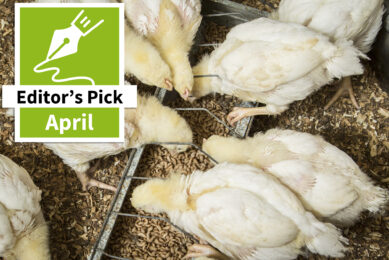Superdosing and the wet litter challenge
![A quality-control employee of a poultry slaughterhouse examines a case of footpad dermatitis. [Photo: Ton Kastermans]](https://www.allaboutfeed.net/app/uploads/2020/12/001_483_rb-image-2693378.jpeg)
The need to overcome the problems associated with wet litter is perhaps greater than ever, with footpad dermatitis (FPD) among broilers of increasing concern from a welfare perspective, as well as an economic one.
The challenge for the poultry industry is that litter quality is a ‘multi-factorial’ issue, with management, building design, ventilation and bird nutrition all affecting the outcome. But this also means that small changes and attention to detail in a number of areas, including feed, taken together can result in significant improvements. For poultry producers, the potential financial losses associated with wet litter due to reduced end-product quality, increased infection levels and lower growth rates are significant. The European Union (EU) Broiler Welfare Directive has placed pressure on producers to overcome wet litter problems, since footpad dermatitis (FPD) is one of the parameters for judging broiler welfare. From a nutritional perspective, the main focus is on tackling the issue of increased digesta viscosity, which raises faecal water content and is one of the main causes of poor litter quality. This effect is the direct result of the long-chain non-starch polysaccharides (NSPs), such as xylans, present in wheat-based diets in particular, although these NSPs are present in all poultry diets to some extent.
Litter is drier with superdosing
It is for this reason that the use of xylanase feed enzymes has become widely accepted as a key element in strategies to resolve wet litter problems, breaking down those long-chain NSPs responsible for increasing digesta water content. However, recently released results from both scientific trials, as well as field trials run on a number of broiler farms in the UK, have highlighted the additional positive role that phytase can play. Although phytases are not typically considered in relation to litter quality, it is now becoming clear that when phytase superdosing (typically three to four times the standard phytase dose rate) is employed, litter is drier and there is an observable decrease in the incidence of FPD. Faecal moisture content is closely linked to digestive efficiency, so the ability of phytase superdosing to deliver significant improvements in nutrient digestion and absorption can have a direct impact on litter quality.
Phytase superdosing produces these benefits by targeting the near complete destruction of in-feed phytate, which is a potent anti-nutrient. This anti-nutrient effect includes phytate’s ability to bind with minerals and proteins in the diet, making them unavailable for digestion. The resulting mineral imbalance and reduction in protein digestion can increase water intake and lead to poor gut health, both of which contribute to increased litter moisture levels. By driving phytate towards elimination, superdosing removes its anti-nutrient effects, thereby increasing protein and mineral absorption and thus improving litter quality. There is also the added benefit of the three to four point improvement in weight-corrected feed conversion ratio (FCR) achieved when superdosing.
Proven reductions in FPD
The impact of phytase superdosing on litter quality has been confirmed in a number of European research trials. In one of these trials, the use of an enhanced E.coli phytase at standard (500 FTU/kg) and superdosed (1,500 FTU/kg) levels was evaluated in broilers.

Superdosing improved bodyweight-corrected 1-42 day FCR from 1.60 to 1.56, and increased 42-day bodyweight from 3.475 to 3.547 kg (P<0.05). in addition, the litter quality score improved and the water-to-feed intake ratio tended to be lower for birds receiving the superdosed levels of phytase. the incidence of fpd was reduced, with significantly more birds in the superdosed group having clean feet (figure 1). these results confirm the additional gains in litter quality available from this novel concept and are backed up by growing industry recognition of the commercial importance of phytase superdosing in addressing wet litter problems. but the role played by xylanase in improving litter quality remains the same and will continue to be important.></0.05).>
Correct xylanase choice
It is vital that the correct xylanase is selected if gut content viscosity and litter moisture are to be reliably and consistently reduced. The xylanase not only needs to be highly effective at breaking down soluble long-chain NSPs, it also needs to be sufficiently stable to reach the broiler small intestine in an active state and to remain active under the conditions in the gastro-intestinal tract. A trial was carried out at Schothorst Feed Research in the Netherlands with litter a quality score (1 = poor; 10 = good) determined between days 34 and 36. The results confirmed that pens where the xylanase was fed had a significantly (p<0.05) higher litter quality, with a score of 6.69 versus 5.75 for the control. there was a corresponding sig-nificant reduction in digesta viscosity (measured at day 22), from 10.82 to 4.92 cps (centipoise), along with a significant improvement in overall fcr, from 1.747 to 1.666 (p><0.05).></0.05).></0.05)>
Also read: Complexed zinc reduces foot pad dermatitis
Conclusions
When an effective xylanase is selected, it is clear that the potential benefits in terms of litter quality and subsequent reductions in issues such as FPD, breast lesions and hock damage are substantial. What is also now clear is that there are additional gains to be made from the use of phytase superdosing as part of a combined feed enzyme approach to wet litter problems. Along with the significant improvements in FCR, such gains mean that this novel approach is likely to be of interest to a wide range of commercial poultry producers. It also expands the role that feed can play in reducing the problems associated with wet litter, to the benefit of both the poultry producers and the feed industry that supplies them.
Join 26,000+ subscribers
Subscribe to our newsletter to stay updated about all the need-to-know content in the feed sector, three times a week. Beheer
Beheer










 WP Admin
WP Admin  Bewerk bericht
Bewerk bericht